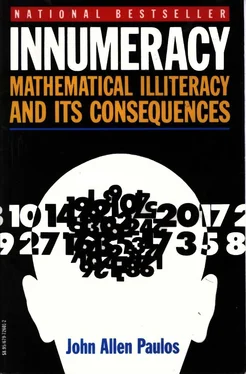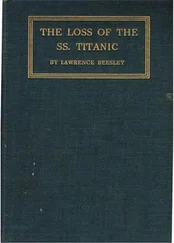John Paulos - INNUMERACY - Mathematical Illiteracy and Its Consequences
Здесь есть возможность читать онлайн «John Paulos - INNUMERACY - Mathematical Illiteracy and Its Consequences» весь текст электронной книги совершенно бесплатно (целиком полную версию без сокращений). В некоторых случаях можно слушать аудио, скачать через торрент в формате fb2 и присутствует краткое содержание. Жанр: Математика, Математика, на английском языке. Описание произведения, (предисловие) а так же отзывы посетителей доступны на портале библиотеки ЛибКат.
- Название:INNUMERACY: Mathematical Illiteracy and Its Consequences
- Автор:
- Жанр:
- Год:неизвестен
- ISBN:нет данных
- Рейтинг книги:5 / 5. Голосов: 1
-
Избранное:Добавить в избранное
- Отзывы:
-
Ваша оценка:
- 100
- 1
- 2
- 3
- 4
- 5
INNUMERACY: Mathematical Illiteracy and Its Consequences: краткое содержание, описание и аннотация
Предлагаем к чтению аннотацию, описание, краткое содержание или предисловие (зависит от того, что написал сам автор книги «INNUMERACY: Mathematical Illiteracy and Its Consequences»). Если вы не нашли необходимую информацию о книге — напишите в комментариях, мы постараемся отыскать её.
Topics include probability and coincidence, the birthday problem, innumeracy in pseudoscience, and statistics and trade-offs in society.
INNUMERACY: Mathematical Illiteracy and Its Consequences — читать онлайн бесплатно полную книгу (весь текст) целиком
Ниже представлен текст книги, разбитый по страницам. Система сохранения места последней прочитанной страницы, позволяет с удобством читать онлайн бесплатно книгу «INNUMERACY: Mathematical Illiteracy and Its Consequences», без необходимости каждый раз заново искать на чём Вы остановились. Поставьте закладку, и сможете в любой момент перейти на страницу, на которой закончили чтение.
Интервал:
Закладка:
It's clear how the above property of numbers led to Archimedes' famous pronouncement that given a fulcrum, a long enough lever, and a place to stand, he alone could physically lift the earth. An awareness of the additivity of small quantities is lacking in innumerates, who don't seem to believe that their little aerosol cans of hairspray could play any role in the depletion of the ozone layer of the atmosphere, or that their individual automobile contributes anything to the problem of acid rain.
The pyramids, impressive as they are, were built a stone at a time over a period very much shorter than the five thousand to ten thousand years required to move the 12,000-foot Mount Fuji by truck. A similar but more classic calculation of this type was made by Archimedes, who estimated the number of grains of sand needed to fill up the earth and heavens. Though he didn't have exponential notation, he invented something comparable, and his calculations were essentially equivalent to the following.
Interpreting "the earth and heavens" to be a sphere about the earth, we observe that the number of grains of sand needed to fill it depends on the radius of the sphere and the coarseness of the sand. Assuming there are fifteen grains per linear inch, there are 15 x 15 per planar inch and 15 3grains per cubic inch. Since there are twelve inches per foot, there are 12 3cubic inches per cubic foot and thus 15 3x 12 3grains per cubic foot. Similarly, there are 15 3x 12 3x 5,280 3grains per cubic mile. Since the formula for the volume of a sphere is 4/ 3x pi x the cube of the radius, the number of grains of sand needed to fill a sphere of radius one trillion miles (approximately Archimedes' estimate) is 4/ 3x pi x 1,000,000,000,000 3x 15 3x 12 3x 5,280 3. This equals approximately 10 54grains of sand.
There is a sense of power connected with such calculations which is hard to explain but which somehow involves a mental encompassing of the world. A more modern version is the calculation of the approximate number of subatomic bits that would fill up the universe. This number plays the role of "practical infinity" for computer problems which are solvable but only theoretically.
The size of the universe is, to be a little generous, a sphere about 40 billion light-years in diameter. To be even more generous and also to simplify the rough calculation, assume it's a cube 40 billion light-years on a side. Protons and neutrons are about 10 -12centimeters in diameter. The Archimedean question computer scientist Donald Knuth poses is how many little cubes 10 - 13 centimeters in diameter (1/ 10the diameter of these nucleons) would fit into the universe. An easy calculation shows the number to be less than 10 125. Thus, even if a computer the size of the universe had working parts that were smaller than nucleons, it would contain fewer than 10 125such parts, and thus computations on problems which require more parts wouldn't be possible. Perhaps surprisingly, there are many such problems, some of them quite ordinary and of practical importance.
A comparably tiny time unit is the amount of time required for light, which travels at 300,000 kilometers per second, to traverse the length of one of the above tiny cubes, whose edges are 10 -13centimeters. Taking the universe to be about 15 billion years old, we determine that fewer than 10 42such time units have passed since the beginning of time. Thus, any computer calculation which requires more than 10 42steps (each of which is certainly going to require more time than our unit of time) requires more time than the present history of this universe. Again, there are many such problems.
Taking a human being to be spherical and about a meter in diameter (assume a person is squatting), we end with some biologically revealing comparisons that are somewhat easier to visualize. The size of a human cell is to that of a person as a person's size is to that of Rhode Island. Likewise, a virus is to a person as a person is to the earth; an atom is to a person as a person is to the earth's orbit around the sun; and a proton is to a person as a person is to the distance to Alpha Centauri.
THE MULTIPLICATION PRINCIPLE AND MOZART'S WALTZES
Now is probably a good time to reiterate my earlier remark that an occasional difficult passage may be safely ignored by the innumerate reader. The next few sections in particular may contain several such passages. The occasional trivial passage likewise may be quite safely ignored by the numerate reader. (Indeed, the whole book may be safely ignored by all readers, but I'd prefer that, at most, only isolated paragraphs will be.)
The so-called multiplication principle is deceptively simple and very important. It states that if some choice can be made in M different ways and some subsequent choice can be made in N different ways, then there are M x N different ways these choices can be made in succession. Thus, if a woman has five blouses and three skirts, then she has 5 x 3 = 15 choices of outfit, since each of the five blouses (B1, B2, B3, B4, B5) can be worn with any of the three skirts (S1, S2, S3), to yield the following fifteen outfits: B1,S1; B1,S2; B1,S3; B2,S1; B2,S2; B2,S3; B3,S1; B3,S2; B3,S3; B4,S1; B4,S2; B4,S3; B5,S1; B5,S2; B5,S3. From a menu with four appetizers, seven entrees, and three desserts, a diner can design 4x7x3 = 84 different dinners, assuming he orders each course.
Likewise, the number of possible outcomes when rolling a pair of dice is 6 x 6 = 36; any of the six numbers on the first die can be combined with any of the six numbers on the second die. The number of possible outcomes where the second die differs from the first is 6 x 5 = 30; any of the six numbers of the first die can be combined with any of the remaining five numbers on the second die. The number of possible outcomes when rolling three dice is 6 x 6 x 6 = 216. The number of outcomes in which the numbers on the three dice differ is 6 x 5 x 4 = 120.
The principle is invaluable in calculating large numbers, such as the total number of telephones reachable without dialing an area code, which comes to roughly 8 x 10 6, or 8 million. The first position can be filled by any one of eight digits (0 and 1 aren't generally used in the first position), the second position by any one of the ten digits, and so on, up to the seventh position. (There are actually a few more constraints on the numbers and the positions they can fill, which brings the 8 million figure down somewhat.) Similarly, the number of possible license plates in a state whose plates all have two letters followed by four numbers is 26 2x 10 4. If repetitions are not allowed, the number of possible plates is 26 x 25 x 10 x 9 x 8 x 7.
When the leaders of eight Western countries get together for the important business of a summit meeting-having their joint picture taken-there are 8x7x6x5x4x3x2x1 = 40,320 different ways in which they can be lined up. Why? Out of these 40,320 ways, in how many would President Reagan and Prime Minister Thatcher be standing next to each other? To answer this, assume that Reagan and Thatcher are placed in a large burlap bag. These seven entities (the six remaining leaders and the bag) can be lined upin7x6x5x4x 3x2x1 = 5,040 ways (invoking the multiplication principle once again). This number must then be multiplied by two since, once Reagan and Thatcher are removed from the bag, we have a choice as to which one of the two adjacently placed leaders should be placed first. There are thus 10,080 ways for the leaders to line up in which Reagan and Thatcher are standing next to each other. Hence, if the leaders were randomly lined up, the probability that these two would be standing next to each other is 10,080/ 40,320 = 1/ 4.
Mozart once wrote a waltz in which he specified eleven different possibilities for fourteen of the sixteen bars of the waltz and two possibilities for one of the other bars. Thus, there are 2 x 11 14variations on the waltz, only a minuscule fraction of which have ever been heard. In a similar vein, the French poet Raymond Queneau once published a book entitled Cent mille milliards de poиmes, which consisted of a sonnet on each of ten pages. The pages were cut to allow each of the fourteen lines of each sonnet to be turned separately, so that any of the ten first lines could be combined with any of the ten second lines, and so on. Queneau claimed that all the resulting 10 14sonnets made sense, although it's safe to say that the claim will never be verified.
Читать дальшеИнтервал:
Закладка:
Похожие книги на «INNUMERACY: Mathematical Illiteracy and Its Consequences»
Представляем Вашему вниманию похожие книги на «INNUMERACY: Mathematical Illiteracy and Its Consequences» списком для выбора. Мы отобрали схожую по названию и смыслу литературу в надежде предоставить читателям больше вариантов отыскать новые, интересные, ещё непрочитанные произведения.
Обсуждение, отзывы о книге «INNUMERACY: Mathematical Illiteracy and Its Consequences» и просто собственные мнения читателей. Оставьте ваши комментарии, напишите, что Вы думаете о произведении, его смысле или главных героях. Укажите что конкретно понравилось, а что нет, и почему Вы так считаете.












